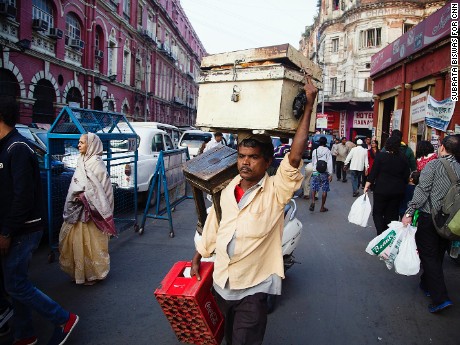
Kolkata, India (CNN)I heard the twangs in November or perhaps early December, after the dampness of the monsoons evaporated and the air carried a hint of winter chill. They were the distinct, almost comical, sounds of the mattress wallahs.
Wallah in Hindi means seller or someone in charge of something, and the mattress wallahs were men who roamed the streets strumming a harp-like wooden implement they used for cotton carding.
The vibration of the bowstring echoed through my neighborhood in Kolkata, and women who ran middle-class households, like my mother, ran out to their balconies to summon the cotton fluffers.
When I was growing up, we slept not on plush foam or box springs but on firm mattresses stuffed with cotton that needed renewal every so often. I watched the mattress wallah carry our quilts, pillows and, of course, mattresses, to our rooftop terrace and gut them of their deflated innards. He used his carder to beat and fluff the existing cotton, added more from his personal supply and then hand-stitched everything back together. That first night after a mattress wallah's visit was nothing short of bliss.
But there are few cotton plumpers left on the streets of my hometown.
Globalization and growth wrought massive change in a very short time. Old ways are dying fast, especially in India's urban centers.
Millions of Indians now find themselves struggling to make a living in niche occupations they've known all their lives. Among them are the mattress wallahs and people in unusual trades that are unfamiliar in the West. They include street typists, snake charmers, water delivery men, broom makers, sugarcane juicers, ironers, street pastry sellers and knife sharpeners.
They were once crucial to my family's livelihood but I notice their dwindling numbers every time I visit India.
A few years ago, a man who ironed my aunt's saris told me about the dire situation he faced. He still had his stall on a street corner and heated his heavy iron on hot coals, but he was losing customers by the day. They now had dryers or electric irons at home, bought clothes made from synthetic fabrics that did not need ironing or used automated cleaning services.
The street ironer worried that soon he would not be able to provide for his family anymore. This was what his grandfather and father had done but his sons would have to enter a different trade. Or they'd be doomed.
I returned to Kolkata last winter thinking about the mattress wallah and the street ironer. Donald Trump promised to bring back jobs to America. But who will advocate on behalf of the men and women in the disappearing trades of India? They are the last of their kind and vanishing fast to extinction.
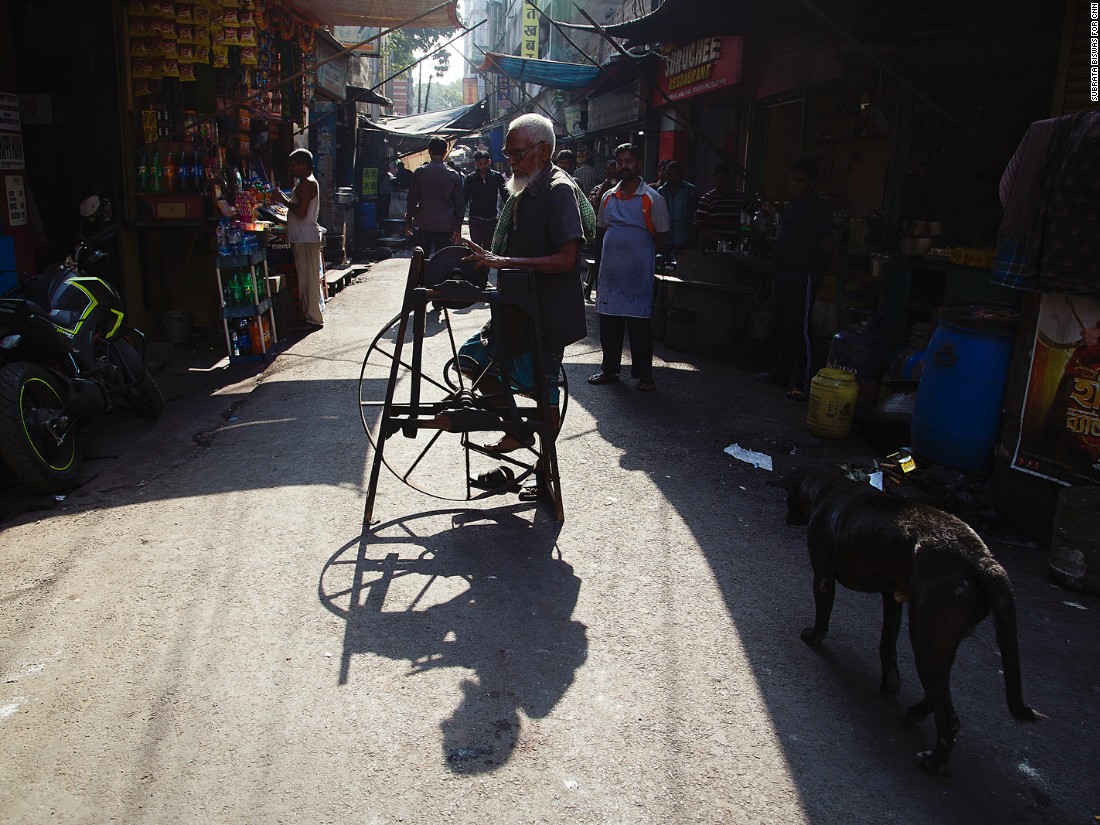
Basir Baig pedals to turn the stone on his sharpening contraption. These days, his customers are mainly owners of eateries in central Kolkata.
At lunchtime in downtown Kolkata, Dacres Lane is better known as tiffin gali or lunch lane. It has been a culinary street since colonial days, when British sailors sought to fill their bellies here.
Basir Baig arrived on this street many years after the Royal Navy left, but he's been sharpening knives for local eateries for the last five decades. He's known as a churi wallah -- churi means knife.
After business in private homes declined, restaurant owners became his primary customers. He's 82 now, his scruffy long beard whiter and his skin browner from years under the Indian sun. He remembers a time when Dacres Lane was saner, before restaurants began spilling over onto the asphalt.
After finishing eighth grade in 1947, the year of India's independence, Baig called it quits on education and took up his trade. He made less than a dollar a day back then, but that was pretty good money. He sent his four kids to school and even though it took all his savings, he considers their education a measure of his success. These days, eight hours of work yields $5, perhaps $6; given inflation, that's about a fifth of what he made as a young man.
On this winter day, Baig manages to find a spot across from the Pink Room, whose sign proudly advertises its air-conditioned dining room and attached bar.
A cook from another nearby eatery brings over three dulled knives; one is a menacing meat cleaver. Baig begins pedaling to turn the stone on his sharpening contraption. He bought his first machine for less than 30 cents; now it costs more than $70, he tells me. It takes him three minutes to sharpen a small knife, more for larger blades.
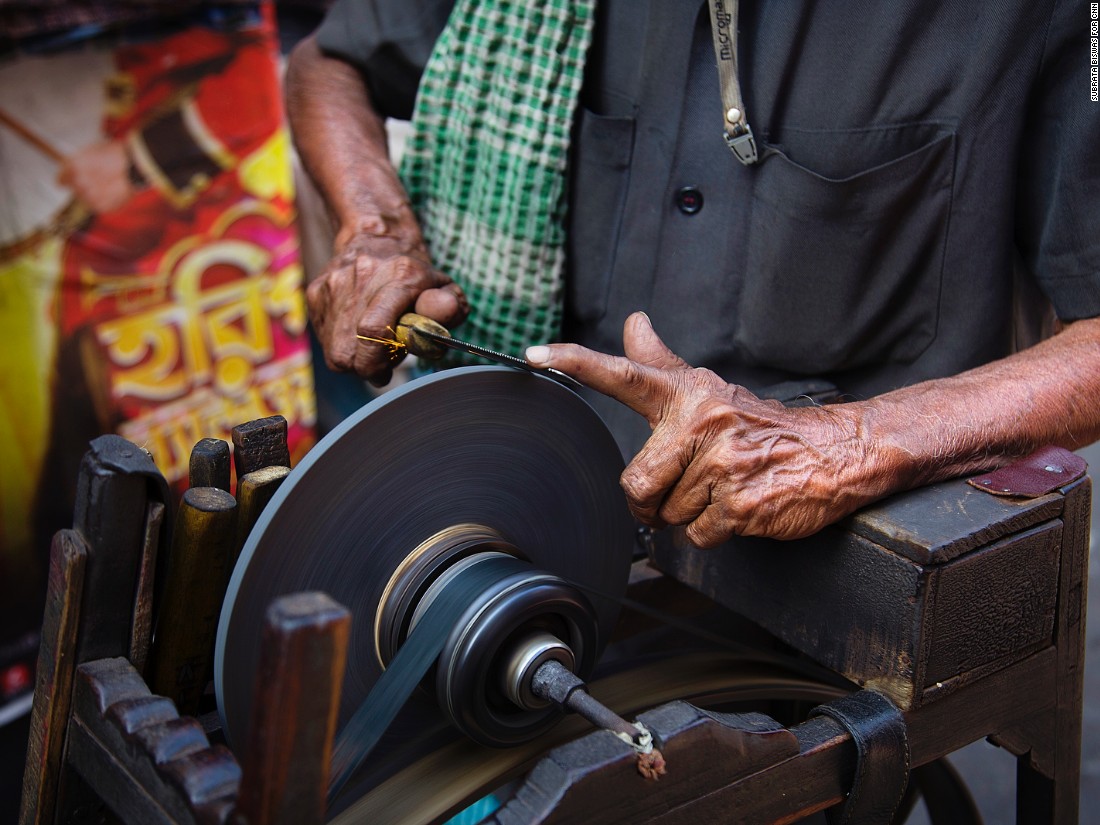
Baig is 82 now and has been sharpening knives since he quit school after the eighth grade.
His joints hurt from the pedaling, and he's had eye surgery to retain the sharp vision he needs for his profession. But he has no regrets.
"My main priority has been to feed my family," he says. "I am poor but I am satisfied with whatever Allah has given me. "
It used to be that the women of the house couldn't chop and dice without the help of their churi wallah.
"They waited for me for days," Baig says. "They depended on me."
But now people buy knives from big stores, and they don't require sharpening, he says. What saddens Baig is that he no longer feels essential to people's lives.
"I am afraid I am not needed anymore."
The bell at Elite Cinema rings at 4:05 p.m., signaling intermission at the matinee showing of the Bollywood crime thriller "Wajah Tum Ho" (You are the Reason). Sheikh Saeed wastes no time.
He rushes with his trunk and stool to the entrance and presses his face against a folding metal gate, like the ones in old elevators. He opens the tired trunk, picks out a vegetable patty, places it in a bag made from newspapers and thrusts his right hand out, eager to lure a hungry moviegoer.
"Bhaiya!" he yells using the Hindi word for brother. "They are hot and tasty."
He has five minutes before people return to the darkness of the theater, one of Kolkata's oldest movie houses.

Sheikh Saeed sells vegetable and meat patties from a trunk near Kolkata's New Market. He keeps them warm with hot coals.
But few are interested in Saeed's treats these days. They bring their own chips or nuts to the theater -- or head to the concession stand. And the crowd at the Elite is smaller. In its heyday the manager posted a sign that read "House Full" to indicate sold-out shows. Now people flock to shiny new American-style multiplexes. On afternoons like this, the clientele here consists mostly of single men taking a break from the office or the occasional young couple on an illicit afternoon date.
Saeed has little luck today. He and two other vendors sell only five patties. Between them, they earn less than a dollar.
When I was young, vendors like Saeed walked the streets selling baked goods.
I was especially fond of a woman who carried a black metal trunk on her head with three trays of pastries inside: The top layer held vanilla, the middle was strawberry and at the bottom was my favorite: chocolate. I watched as she lowered the trunk under a searing Bengal sun and marveled at her strength to carry such a load in the heat. The pastries were pure sugar and fat, and my mother resisted buying too many. But she took a certain amount of pity on the pastry wallah, and my brother and I always each got two -- one for instant gratification and one saved for after dinner.
On my last visit to Kolkata, I tried in vain to find a pastry wallah. I was told they had faded with the explosion of top-notch bakeries and Starbucks-style coffee houses that sell everything from cookies and cupcakes to vegetable and chicken patties.
No wonder Saeed is barely in business.
There was a time when he, too, took his trunk to people's homes and opened it up to the delight of customers. But sales dropped precipitously in the last few years. Saeed guesses he's now competing with 15 to 20 other wallahs of his kind left in Kolkata.
He sells his patties mostly in central Kolkata -- in front of cinema halls, at the maidan (the city's equivalent of Central Park) and on the congested streets around New Market, a British-era market that was the place to shop when I was growing up.
He keeps his patties warm with hot coals that line the bottom of the trunk. It's tough to carry the 15-pound trunk on his head, even tougher in Kolkata's endless summers.
He shows me his tray of neatly lined patties. "Veg" on one side that sell for 15 rupees (22 cents) and "Non-veg" on the other for 20 rupees (29 cents). Twenty years ago, he would sell 500 of these on a good day. Now he's lucky to sell 30 in the 10 hours he works everyday.

Saeed and two other patties vendors wait for customers outside the Elite Cinema hall. But few come.
He has two daughters who completed high school and two younger sons. He tells me he struggles to support them.
"I try to make up the deficit by going to festivals and fairs, but I can't rely on that on a daily basis," he says.
Saeed is 45 and has to keep working for the sake of his family.
"Why don't you try to do something else?" I ask.
"But this is what I have done since I was a boy," he replies. "I don't really know how to do anything else."
Besides, he says, he pays the police 200 rupees every month for his space on the street. Many of Kolkata's vanishing vendors pay small bribes to operate on public sidewalks and streets, Saeed tells me. If he switches turf or begins selling something else, he will probably have to pay more.
So, he'll stay here, he says. And take his chances.
In the village on the outskirts of Kolkata that Archana Hazra calls home, more than 60% of the people share the same profession. They are zari karigars.
Zari is brocaded thread -- usually gold or silver -- used in intricate embroidery to embellish clothing, and karigar means artisan. When I was young, I thought myself special when I received a sari with zari work.
Sometimes the zari is married with sequins and beads for more elaborate and delicate designs known as zardosi, which surfaced in popular clothing lines in America after trade with India began to open up in the 1990s. It was the big companies, not the zari workers, who profited from the export boom.
Hazra, 28, quit high school for zari work. It was good money then, and she wanted to help her parents out.
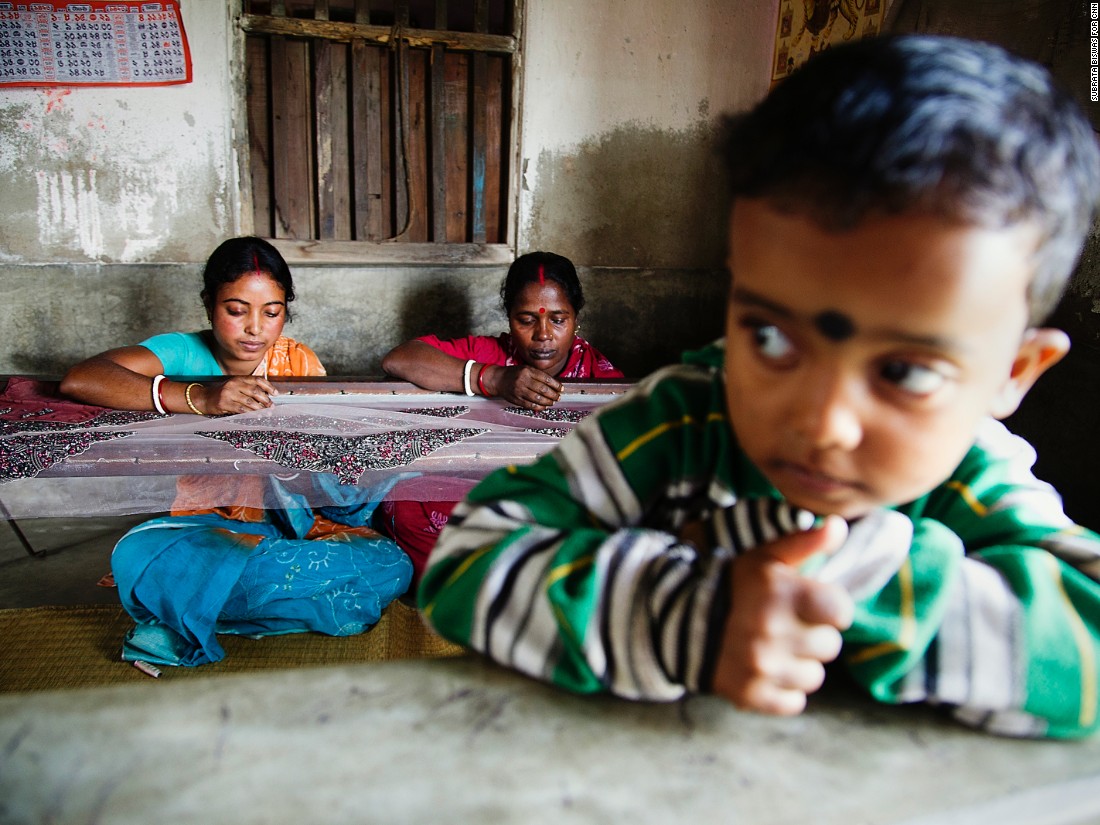
Archana Hazra and her mother, Sandhya Sardar, are both brocade embroiderers, but Hazra doubts there will be any work left by the time her infant daughter Papri grows up.
Most people in her village, Panchla, live in modest one-room homes. They have brick walls and tin roofs, if they are lucky. Many make do in mud huts with thatched roofs.
Hazra's husband is also an embroiderer -- as are her four sisters and brothers. So was her mother, Sandhya Sardar, until five years ago when her vision diminished. She still had nimble fingers but not the sharp eyes needed for detailed work.
Hazra recently developed an eye infection from the kajal, or kohl, she bought for her baby girl. Kajal is believed to have a soothing effect. Superstitious Indians also believe it wards off evil and apply the cosmetic to their baby's forehead and eyes soon after birth.
Hazra tested the kajal on herself first to make sure it was not adulterated. Sure enough, her right eye swelled and turned red; the reaction was so severe that she worried she, too, like her mother, would have to abandon embroidery.
"If my eyes go, so does my work," she tells me.
Her eye healed but her profession is ailing.
"The computer," she says, "is the end of us."
"Computer?" I ask.
Hazra leads me to a small building five minutes away. It houses an enormous machine, made in China, with giant spools of thread threading needles that work at lightning speed. In contrast, Hazra spends hours hunched over a dhadda, a wooden frame that stretches out the silk, chiffon, georgette or crepe she is adorning.
"What takes me seven days to do, the computer does in an hour," she says. "They do it faster but my work is better."
Automation has arrived, even in this sphere of traditional work that harkens back centuries to the heavy silk robes and saris of emperors, empresses and courtiers.
"Zari work will always be there," Hazra says. "Just that there is less work for people like me."
She is one of 600,000 or so other zari workers who live in villages and towns across the river from Kolkata that gained fame for their embroidery.
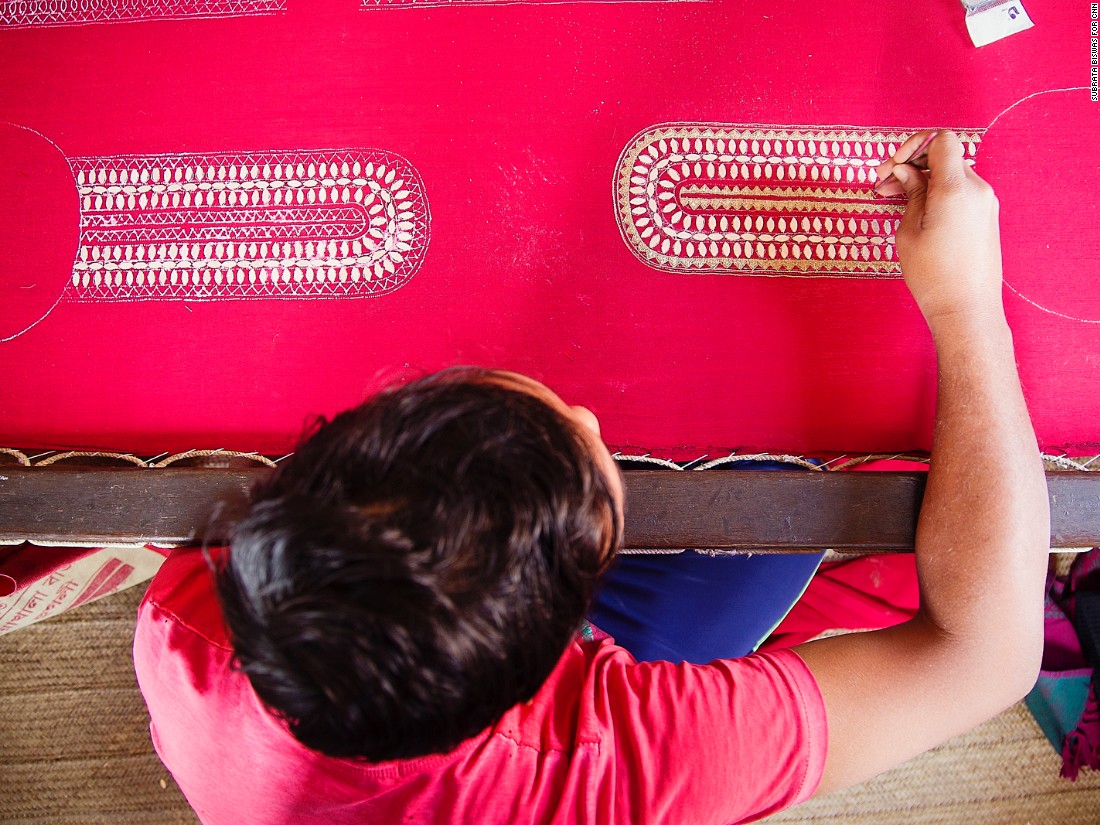
A lot of zari embroidery has been automated and artisans are being forced to abandon their trade.
Besides automation, the workers themselves have lost clout over the years as middlemen called ostagars stepped into the zari business. They buy the fabric and get the contracts with companies that sell clothing and bags in upscale malls in India and abroad. The wedding trousseau business is particularly big for zardosi work.
But the middlemen cut out the zari workers from the profits, says Farid Mullah, leader of the local Forward Block political party. The party headquarters proudly flies its red flag emblazoned with a tiger and the communist hammer and sickle.
Mullah says zari workers -- many of whom are women or children -- often work 12 to 16 hours hunched over yards of cloth but make shameful wages. Maybe $4 on a good day.
Hazra and her husband now struggle to make a decent living. Zari workers like them make less than $2 a day -- hardly enough for the couple and their two young children.
"The middlemen make the money, but the workers are in a dire situation," Mullah says.
Some villagers have tried to find other jobs like operating cycle rickshaws or getting on the assembly line of the factories that have popped up in the area. Hazra landed one such job at a pen factory. She reports to work at 8:30 in the morning and works until 6:30. Her husband set up a small potato stall at the market. They still do zari work -- when they get it -- but their wages have fallen from $85 a month to about $20.
"People make noise about saving us," Hazra says. "But no one ever does. We are a dying breed."

Pandit Mahender Pandey Shastri sits on one of Kolkata's main thoroughfares with a pair of parrots that help him tell fortunes.
Every morning at 7, Pandit Mahender Pandey Shastri offers prayers for three hours before making his way to Chowringhee, the Champs-Elysées of Kolkata.
Chowringhee was officially renamed after India's first prime minister, Jawaharlal Nehru, though nobody calls it that. During the day, the wide avenue swells with commuters, shoppers and tourists. Kolkatans know they don't even have to walk; the tide of humanity carries everyone and everything in its path.
Amid the snarl, Shastri, a jyotishee, or fortune-teller, conducts business from a mat on the sidewalk in front of the Indian Museum. Behind him dangle dust-laden branches of a Mahua tree. In front is a small hand-painted sign that announces his presence.
"Meet or write for every astrological problem."
On this day, Shastri, 70, is wearing a saffron dhoti (a garment worn by Hindu men) and a batik scarf hugs his neck. A red mark on his forehead tells the world he has been to the temple to pray. Next to him are his two prized parrots nestled in a small cage painted green to match their feathers. Their names are Radha and Krishna, after Hindu gods, and they are Shastri's assistant fortune-tellers.
For a mere 30 cents, the birds hop out of their cage on Shashtri's command and pick out one of the 100 cards neatly arranged face down on the mat. Each contains a message not unlike those found in fortune cookies, only longer and far more detailed.
Parrot astrology is an ancient tradition in India and people turn to it for help navigating life. Parrot astrologers determine compatibility for prospective brides and grooms. They are consulted when someone in the family falls seriously ill or obtains a good job. And they foretell suitable dates and time of day for big occasions like a marriage ceremony.
Shastri's astrological accoutrements include gemstones that represent the planets. Coral, for instance, enhances the positive energy of Mars and should be worn by those in need of confidence. Pearls represent the moon, and if there is a beneficial moon in a customer's horoscope, Shastri recommends wearing one.
Shastri also reads palms, When I extend my left hand, he inspects it by looking through a magnifying glass missing its handle. His eyes scan the lines of my hand and he concludes that the last 2½ years have not been easy.
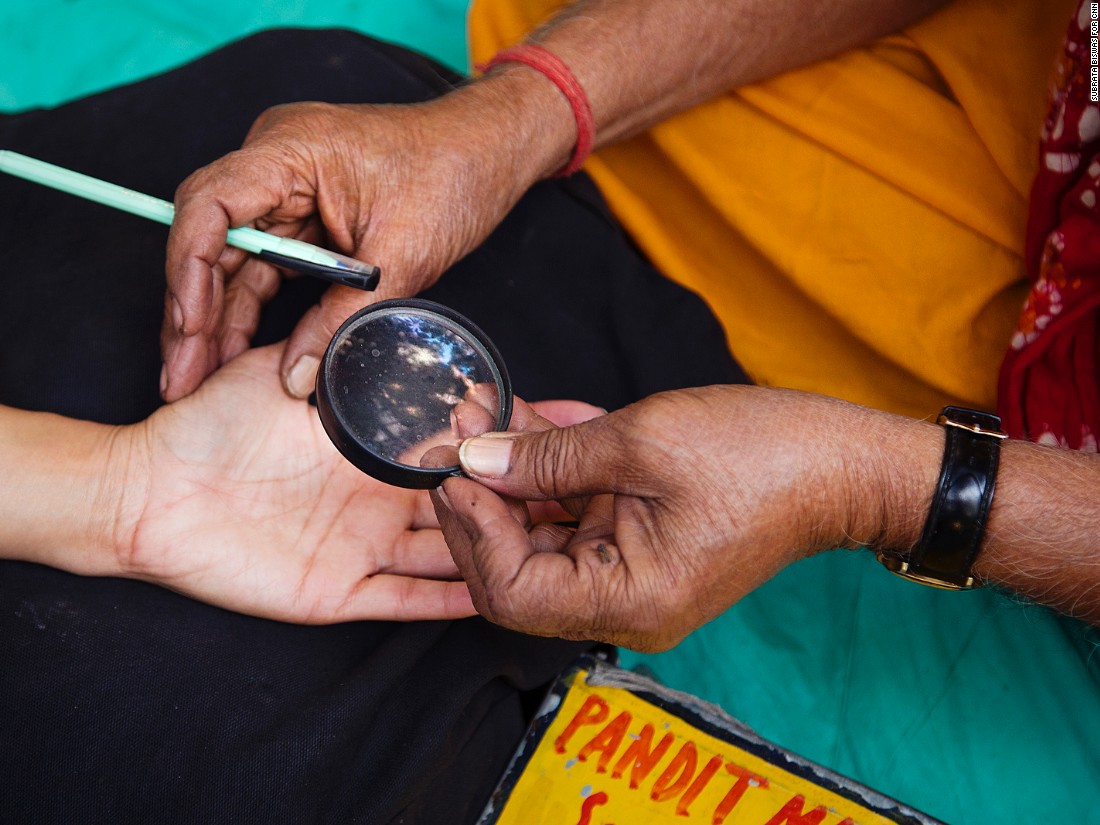
Shastri reads the author's palm and says many people just don't believe in astrology anymore.
"You should worship God more to relieve your tensions," he says.
I nod my head and ask Shastri how things are going. He's been an astrologer since 1969 and says people these days have other means of figuring out their lives. They don't need someone like him for advice. Even if they do, they can always go online and look up their horoscopes.
"A lot of people don't even believe in all this anymore," he says, giving me the eye.
They're skeptical of Shastri's unique blend of science, mysticism and skill. They say it's hocus pocus.
There are too many cynics and too much information around for Shastri to make a profit, he tells me. Good thing one of his sons decided to run a clothing shop; another farms for a living.
He takes a sip of masala chai from a tiny disposable cup that can barely hold the heat of the tea. Gone are the terra cotta cups that made afternoon tea so much more satisfying.
It's dark by the time Shastri begins to pack up for the day. The sun sets before 5 in the winter, and the priest makes his way home by 6. It's not worth it for him to sit through the evening rush. Too few customers.
I pay him for reading my palm and extend my good wishes to the priest and his parrot partners.
"Good luck," Shastri says. "Good luck."

Mohammed Golam Rasul uses a harp-like instrument to fluff cotton to restuff mattresses and pillows.
In a small, dark warehouse near the left bank of the Hooghly River, five men pound piles of cotton with wooden sticks. They heave their arms high in the air and beat the cotton with every ounce of their strength. They can work 5 pounds of cotton within 10 minutes. They are Kolkata's dhunia, or cotton carders.
The afternoon light catches a flurry of fluffy white particles that swim through the air and land on the heads of the workers, coating their oil-slicked hair. It's an asthma sufferer's hell and within minutes, I begin coughing from the fibers in my throat.
I ask Mohammed Golam Rasul, 60, to step outside. He emerges from the dark looking like he's just been in a pillow fight.
"How can you breathe in there?" I ask.
He tells me many of his colleagues suffer from lung ailments like tuberculosis from breathing the cotton dust.
Rasul has been beating cotton like this for the past 36 years. His father, grandfather and great-grandfather did the same. The family has been in the business for 200 years, he says.
But 20 years from now, they won't be. There's hardly any money to be made these days in this old-fashioned mattress industry. Rasul is lucky to make $3 a day.
Rasul once wandered city streets like the mattress wallahs of my youth. Back then, only the wealthy could afford foam and coir mattresses and Rasul kept busy. But at the start of this century, stores filled with soft, cushy bedding, and work slowed for the cotton plumpers.
The warehouse where Rasul works is in Bandhaghat, a 100-year-old market known for its cotton trade. Its proximity to the river makes it easier to transport bales of cotton.
Subrata Kundu runs a family-owned bedding shop in Bandhaghat and tells me when he started in the business 40 years ago, there were no machines involved in the bedding industry. Not even cotton gins.
Though the market is a sliver of its former self, Kundu says the customers who shop at his store remain faithful to hand-made mattresses. They are cheaper, better for your back and completely sustainable, he says.

Inside a dark warehouse on the banks of the Hooghly River, workers use all their strength to plump old cotton.
As though on cue, a customer arrives with an old quilt to be re-stuffed. Kundu inspects the cotton inside and provides an estimate: 900 rupees ($13) to get the quilt looking new. The customer agrees.
"I've been shopping here for 30 years," Tapas Adhikary tells me. "All my wedding stuff came from here. There's nothing like these mattresses and quilts."
I leave Kundu's shop with optimism that there are still loyal customers who patronize the mattress wallahs. But, sadly, not enough.
Rudyard Kipling immortalized the bhisti in his poem "Gunga Din," the water carrier who brought nourishment to British officers on the battlefield. But even before that, there were tales of heroic bhistis who carried water in thick leather mashaks, bags made from goat skin, and delivered them to the Mughal emperors of India.
It was a trade passed down from father to son with an enormous sense of pride. Mohammad Ansur Ali's father was a bhisti. So was his grandfather. Men like him once were a common sight in Kolkata.
Not anymore.
I have to ask around to find Ali and wait for him at a tubewell just off Kolkata's Lindsay Street. He's one of a handful of bhistis left in the city.
Across the narrow lane, a few men sip tea at a sidewalk stall and watch the 28-year-old as though he were performing street theater. Ali pushes down with the entire weight of his muscular body to fill his 8-gallon mashak and then hoists it over his left shoulder. He doesn't flinch even though it weighs close to 80 pounds.
Ali does this 60 to 70 times a day. His first runs are from 5 in the morning to noon. He takes a lunch break and then is back on the job from 3 until 7.
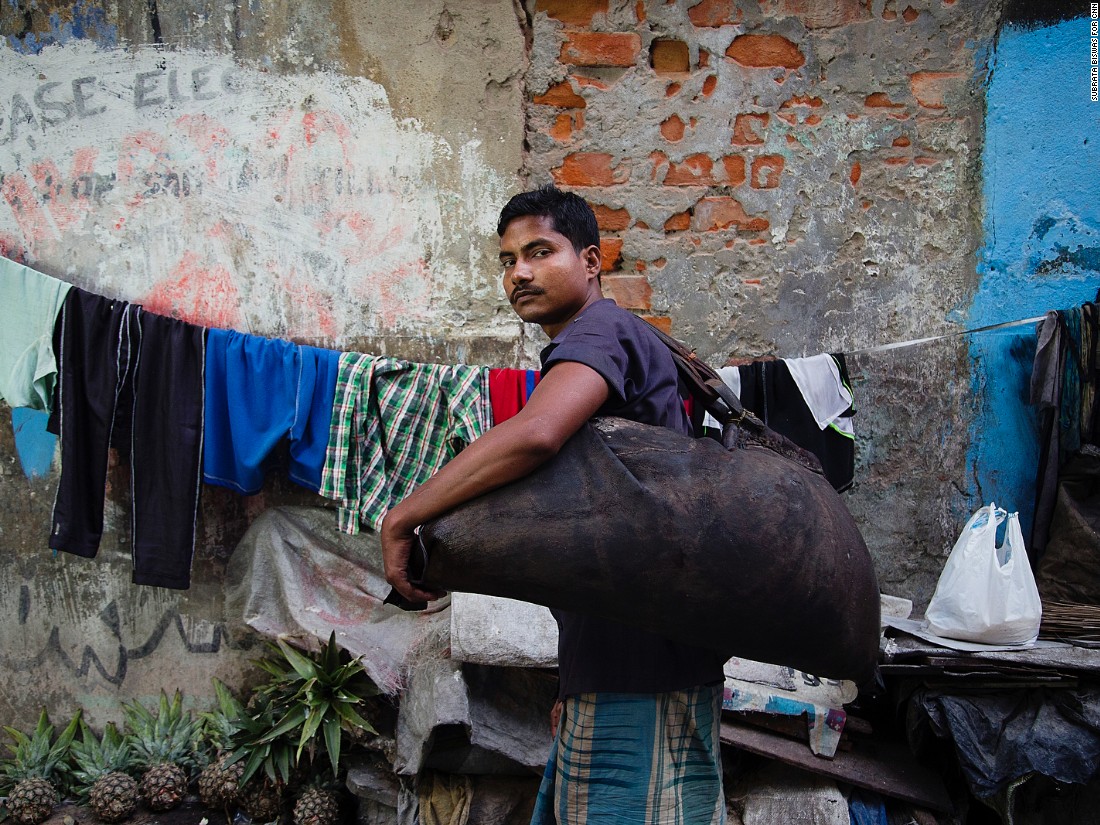
Mohammad Ansur Ali carries delivers water to homes and businesses in a mashak, a bag made from goat skin.
"Slowly, business is going down," Ali says. "It's a lot of hard work for very little money. So men are leaving this job whenever they can. Besides, people have pipes now."
He means that most people have access to city water now that flows from the Tala Tank in north Kolkata and is pumped up to rooftops before it comes out of gravitational systems connected to bathroom and kitchen faucets.
I try to keep up with Ali as he begins his half-mile sprint down narrow lanes and side streets. He runs barefoot for speed, he says. Gets better traction this way. Sometimes, he climbs eight or nine flights of stairs.
"This is a job for the young and strong," he tells me. "You cannot do this after 40."
Ali has two daughters and a son. But he took this job because he has five sisters, and his father needed help in getting them married. Two are still at home.
We arrive at the Modern Book House on Mirza Ghalib Street, and I watch Ali slip into a dark and skinny stairwell to the second floor, where the store owner's family lives. He delivers here once a day and gets paid about $3 a month for his services.
There's every kind of book in the store: from Anne Frank's diary to daily yoga poses. But no customers. Owner Mohammed Aziz asks what I am looking for.
"I'm following the water delivery man for a story," I tell him.
"Well, you ought to write about the small new and used bookshops that were once prevalent in this part of town," Aziz says. People read everything online now. Even I will go out of business soon."
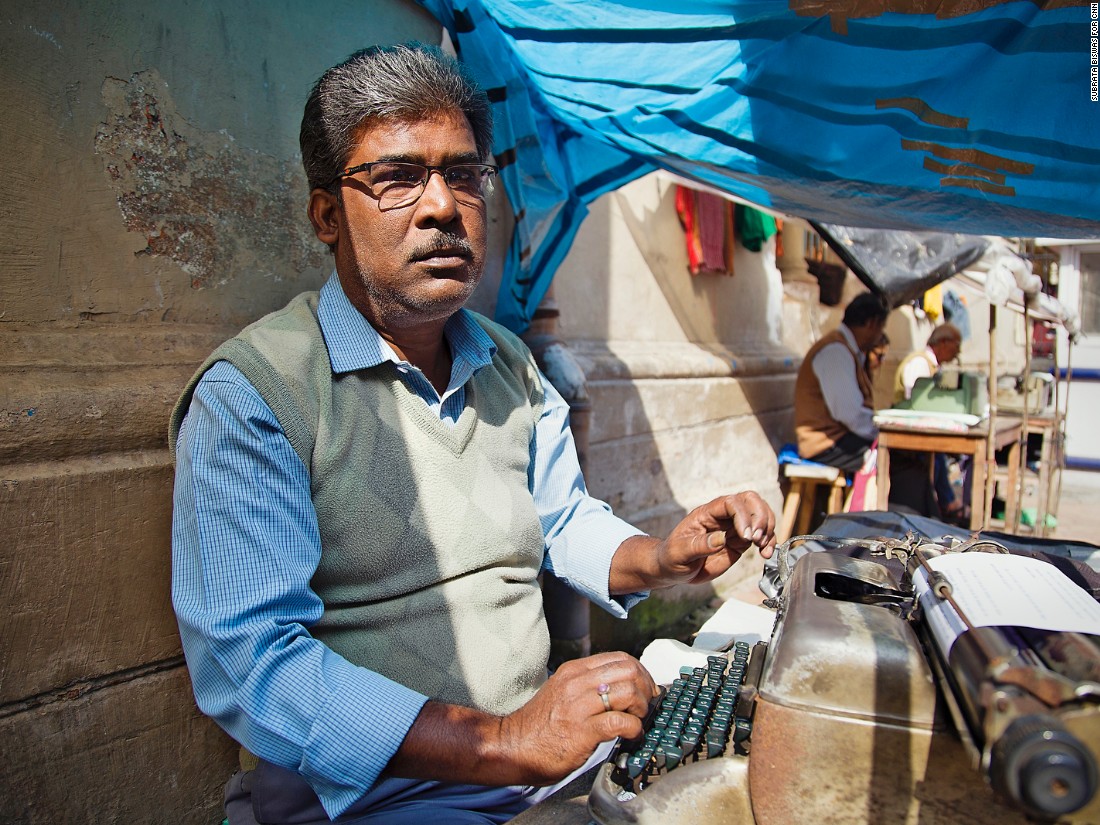
For more than 25 years, D.N. Bhattacharya has been sitting outside Kolkata's high court, typing legal documents on a manual typewriter.
Outside Kolkata's high court, a group of men sit facing Remington typewriters on splintered tables. Plastic tarps give the typists shelter from the sun and the torrential monsoonal rains that flood Kolkata every year.
D.N. Bhattacharya tells me the humidity is so high during the rainy season that the paper he types on curls, and the ink begins running before it can dry. But that's the least of his worries.
He's been typing legal documents almost half his life. He took a typing class when he was 18 and by the time he turned 26, he was doing this full time. I watch him punch keys on his manual typewriter from another century faster than I can on a brand new MacBook.
Typists like Bhattacharya used to complain their fingers turned blue from the constant tapping. They typed all sorts of papers for my family. Even when I sold my parents' house a few years ago, the deed was typed outside the courthouse.
They typed official letters for businessmen, resumes for job seekers and even letters for lovebirds. Typing was not an essential skill taught in schools like it was in America -- I never learned Qwerty -- and street typists were very much in demand.
"So many people in Kolkata don't know how to type," Bhattacharya tells me. "They don't understand legalese or they don't know how to make corrections."
He was good, he proudly admits. "No one could keep up with my speed."
He'd knock out 40 to 50 pages a day. Easy.
But everything changed with the advent of desktops and laptops and now mobile devices.
Bhattacharya is 50 and one of the last of Kolkata's street typists. He tells me there were once 212 typists who worked at the high court. Today, there are fewer than 10.
"Now that everyone has computers, my work has dropped 70%," he says.
He tried to make up for lost wages by raising his price -- from 2 rupees per page to 10 (that's about 15 cents). But it doesn't fill the gap. On average, he's only typing 10 pages a day.
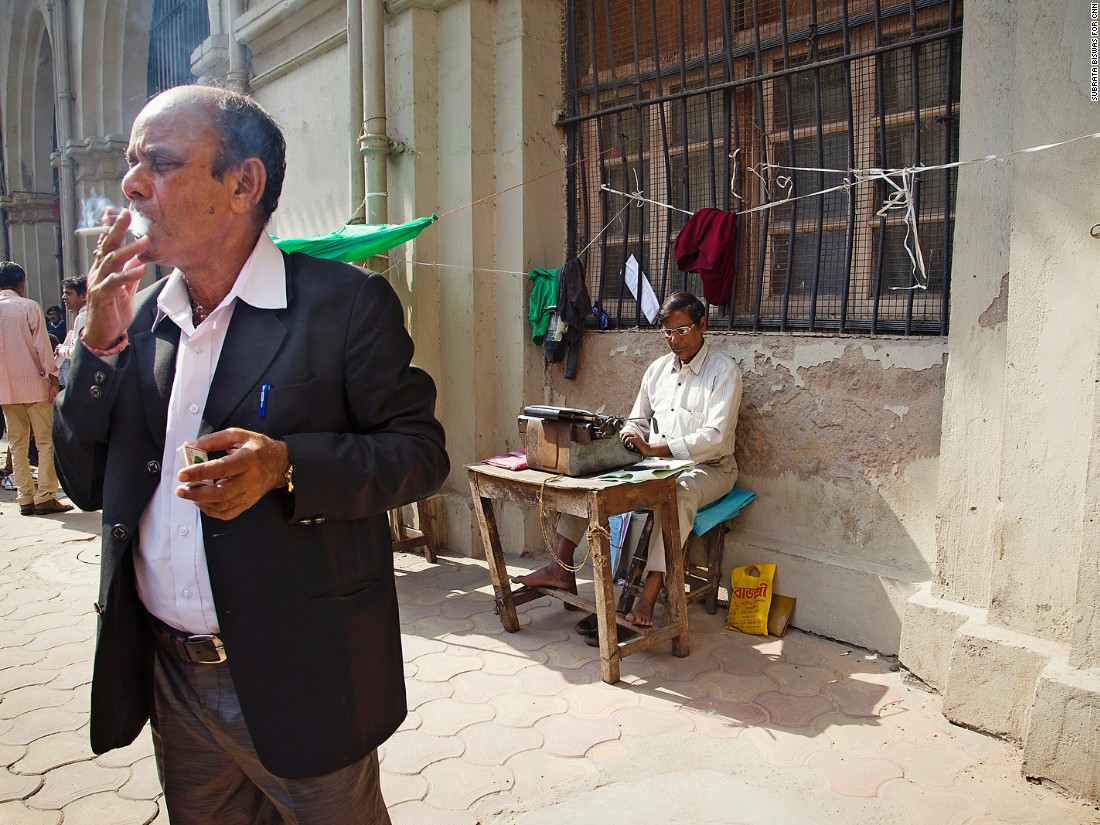
As courts move to digital filing, work is dwindling for Kolkata's street typists.
Computerization has meant many things. Lawyers who flocked to the street typists to get their legal briefs in order now have assistants in their offices who have templates on laptops. And as court records are stored online, judges are demanding uniformity in legal documentation.
A chief justice already tried once to have the typists evicted from the high court's sidewalks. Bhattacharya comes to work every day knowing that a new declaration could come down at any time: No more filings on manual typewriters.
"That will be the end of us," he says.
Bhattacharya has no health benefits or retirement account. There is no union that represents street typists. He wonders what he might do if the work stops altogether. Maybe he will try to get on as a clerk; not many people in Kolkata possess his speed and accuracy in typing.
Our conversation is interrupted by R. Islam, a high court lawyer who still utilizes the street typists. He has come with a brief to be typed. He takes off his freshly polished loafers, crosses his legs on a wooden bench next to Bhattacharya.
"I have a computer but I don't use it," he tells me. "I sit here until all hours of the evening dictating.
"But we are digital India now. This machine is irrelevant," Islam says, placing his left hand on Bhattacharya's Remington.
We talk about how Indian software engineers have contributed a great deal to the world of computers. The irony does not escape anyone, and an uncomfortable silence ends the discussion.
Then Bhattacharya switches from Bengali to English.
"The future," he says, "is completely dark."